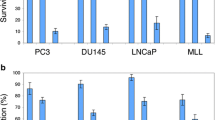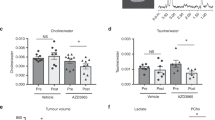Abstract
Purpose
The aim of the study was to investigate the intracellular location of [methyl-3H]choline in MCF7 tumour cells and to determine the relationship between [methyl-3H]choline incorporation and proliferation.
Methods
Tumour cells were incubated with [methyl-3H]choline for 10 min, and then in cold medium to simulate the rapid blood clearance of [methyl-11C]choline. Labelled metabolites were then extracted from cells by treating them with organic and aqueous solvents to determine the distribution of tracer between phospholipid and water-soluble metabolite pools. Aqueous extracts were subjected to thin-layer chromatography, ion exchange chromatography and a choline extraction procedure to identify 3H-containing metabolites. Procedures were carried out on fast- and slow-growing populations of MCF7 cells to determine the relationship between choline incorporation and proliferation.
Results
Only about 5% of [methyl-3H]choline was present as phospholipid. [methyl-3H]choline incorporation was found to be related to S-phase fraction. In another experiment, [methyl-14C]choline incorporation was found to be correlated with [methyl-3H]thymidine incorporation. The Vmax of choline uptake was found to be increased whilst Km was decreased in populations of MCF7 cells with higher proliferative fractions, compared with populations having lower proliferative fractions.
Conclusion
Choline incorporation into tumour cells under conditions that simulate rapid blood clearance of [methyl-11C]choline is correlated with proliferation. Most of the activity (about 95%) was in the non-lipid fraction of the cell.





Similar content being viewed by others
References
Negendank W. Studies of human tumors by MRS—a review. NMR Biomed 1992;5:303–24.
Aboagye EO, Bhujwalla ZM. Malignant transformation alters membrane choline phospholipid metabolism of human mammary epithelial cells. Cancer Res 1999;59:80–4.
Bhakoo KK, Williams SR, Florian CL, Land H, Noble MD. Immortalization and transformation are associated with specific alterations in choline metabolism. Cancer Res 1996;56:4630–5.
Kotzerke J, Prang J, Neumaier B, Volkmer B, Guhlmann A, Kleinschmidt K, et al. Experience with carbon-11 choline positron emission tomography in prostate carcinoma. Eur J Nucl Med 2000;27:1415–9.
Ohtani T, Kurihara H, Ishiuchi S, Saito N, Oriuchi N, Inoue T, et al. Brain tumour imaging with carbon-11 choline: comparison with FDG PET and gadolinium-enhanced MR imaging. Eur J Nucl Med 2001;28:1664–70.
Kobori D, Kirihara Y, Kosaka N, Hara T. Positron emission tomography of esophageal carcinoma using C-11-choline and F-18-fluorodeoxyglucose—a novel method of preoperative lymph node staging. Cancer 1999;86:1638–48.
Hara T, Inagaki K, Kosaka N, Morita T. Sensitive detection of mediastinal lymph node metastasis of lung cancer with C-11-choline PET. J Nucl Med 2000;41:1507–13.
Liu D, Hutchinson OC, Osman S, Price P, Workman P, Aboagye EO. Use of radiolabelled choline as a pharmacodynamic marker for the signal transduction inhibitor geldanamycin. Br J Cancer 2002;87:783–9.
Zeisel SH. Choline phospholipids—signal transduction and carcinogenesis FASEB J 1993;7:551–7.
Wettstein M, Weik C, Holneicher C, Haussinger D. Betaine as an osmolyte in rat liver: metabolism and cell-to-cell interactions. Hepatology 1998;27:787–93.
Tijburg LBM, Geelen MJH, Vangolde LMG. Biosynthesis of phosphatidylethanolamine via the CDP-ethanolamine route is an important pathway in isolated rat hepatocytes. Biochem Biophys Res Commun 1989;160:1275–80.
Kalra R, Wade KE, Hands L, Styles P, Camplejohn R, Greenall M, et al. Phosphomonoester is associated with proliferation in human breast cancer—a P-31 MRS study. Br J Cancer 1993;67:1145–53.
Smith TAD, Eccles S, Ormerod MG, Tombs AJ, Titley JC, McCready VR. The phospholcholine and glycerophosphorylcholine content of an oestrogen-sensitive rat mammary tumour correlates strongly with growth. Br J Cancer 1991;64:821–6.
Daly PF, Lyon RC, Faustino PJ, Cohen JS. Phospholipid metabolism in cancer cells monitored by P-31 NMR-spectroscopy. J Biol Chem 1987;262:14875–8.
Smith TAD, Eccles S, Box G, Titley JC, Leach MO, McCready VR. Phosphocholine content of rat sarcoma cells in the presence and absence of serum. Anticancer Res 1996;16:1389–92.
Smith TAD, Glaholm J, Leach MO, Machin L, Collins DJ, Payne GS, et al. A comparison of in-vivo and in-vitro 31P NMR spectra from human breast tumours: variations in phosphorus metabolism. Br J Cancer 1991;63:514–6.
Warden CH, Friedkin M. Regulation of choline kinase activity and phosphatidylcholine biosynthesis by mitogenic growth factors in 3T3 fibroblasts. J Biol Chem 1985;260:6006–11.
Hara T, Kosaka N, Shinoura N, Kondo T. PET imaging of brain tumor with [methyl-C-11]choline. J Nucl Med 1997;38:842–7.
Roivainen A, Forsback S, Gronroos T, Lehikoinen P, Kahkonen M, Sutinen E, et al. Blood metabolism of [methyl-11C]choline; implications for in-vivo imaging with positron emission tomography. Eur J Nucl Med 2000;27:25–32.
Graham RA, Meyer RA, Szwergold BS, Brown TR. Observation of myoinositol 1,2-(cyclic) phosphate in a Morris hepatoma by P-31 NMR. J Biol Chem 1987;262:35–7.
Ramirez de Molina A, Gutierrez R, Ramos MA, Silva JM, Silva J, Bonilla F, et al. Increased choline kinase activity in human breast carcinomas: clinical evidence for a potential novel antitumor strategy. Oncogene 2002;21:4317–22.
Liscovitch M, Freese A, Blusztajn JK, Wurtman RJ. High performance liquid chromatography of water-soluble choline metabolites. Anal Biochem 1985;151:182–7.
Hoffmann K, Grafe F, Wohlrab W, Neubert RH, Brandsch M. Functional characterization of a high-affinity choline transport system in human keratinocytes. J Invest Dermatol 2002;119:118–21.
Chung TW, Huang JS, Mukherjee JJ, Crilly KS, Kiss Z. Expression of human choline kinase in NIH 3T3 fibroblasts increases the mitogenic potential of insulin and insulin-like growth factor I. Cell Signal 2000;12:279–88.
Katz-Brull R, Seger D, Rivenson-Segal D, Rushkin E, Degani H. Metabolic markers of breast cancer: enhanced choline metabolism and reduced choline-ether-phospholipid synthesis. Cancer Res 2002;62:1966–70.
Warden CH, Friedkin M. Regulation of phosphatjdylcholine biosynthesis by mitogenic growth factors. Biochim Biophys Acta 1984;792:270–80.
Paddon HB, Vigo C, Vance DE. Diethylstilbestrol treatment increases the amount of choline kinase in rooster liver. Biochim Biophys Acta 1982;710:112–5.
Ko KWS, Cook HW, Vance DE. Reduction of phosphatidylcholine turnover in a nb-2 lymphoma cell line after prolactin treatment—a novel mechanism for control of phosphatidylcholine levels in cells. J Biol Chem 1986;261:7846–52.
Katz-Brull R, Degani H. Kinetics of choline transport and phosphorylation in human breast cancer cells; NMR application of the zero trans method. Anticancer Res 1996;16:1375–80.
Utriainen M, Komu M, Vuorinen V, Lehikoinen P, Sonninen P, Kurki T, et al. Evaluation of brain tumor metabolism with [11C]choline PET and 1H-MRS. J Neurooncol 2003;62:329–38.
Lockman PR, Allen DD. The transport of choline. Drug Dev Ind Pharm 2002;28:749–71.
Grundemann D, Gorboulev V, Gambaryan S, Veyhl M, Koepsell H. Drug excretion mediated by a new prototype of polyspecific transporter. Nature 1994;372:549–52.
Koepsell H. Organic cation transporters in intestine, kidney, liver, and brain. Ann Rev Physiol 1998;60:243–66.
Gorboulev V, Ulzheimer JC, Akhoundova A, Ulzheimer-Teuber I, Karbach U, Quester S, et al. Cloning and characterization of two human polyspecific organic cation transporters. DNA Cell Biol 1997;16:871–81.
Sinclair CJ, Chi KD, Subramanian V, Ward KL, Green RM. Functional expression of a high affinity mammalian hepatic choline/organic transporter. J Lipid Res 2000;41:1841–48.
Busch AE, Quester S, Ulzheimer JC, Waldegger S, Gorboulev V, Arndt P, et al. Electrogenic properties and substrate specificity of the polyspecific rat cation transporter rOCT1. J Biol Chem 1996;271:32599–604.
Okuda M, Urakami Y, Saito H, Inui K-I. Molecular mechanisms of organic cation transport in OCT2-expressing Xenopus oocytes. Biochim Biophys Acta 1999;1417:224–31.
Wonderlin WF, Woodfork KA, Strobl JS. Changes in membrane potential during the progression of MCF7 human mammary tumor cells through the cell cycle. J Cell Physiol 1995;165:177–85.
DeGrado TR, Baldwin SW, Wang S, Orr MD, Liao RP, Friedman HS, et al. Synthesis and evaluation of 18F-labeled choline analogues as oncologic PET tracers. J Nucl Med 2001;42:1805–14.
DeGrado TR, Coleman RE, Wang S, Baldwin SW, Orr MD, Robertson CN, et al. Synthesis and evaluation of 18F-labeled choline analogues as an oncologic for positron emission tomography: initial findings in prostate cancer. Cancer Res 2000;61:110–7.
DeGrado TR, Reiman RE, Price DT, Wang S, Coleman RE. Pharmacokinetics and radiation dosimetry of 18F-fluorocholine. J Nucl Med 2002;43:92–6.
Acknowledgements
This work was funded by a Kuwait Government Ph.D. studentship and the University of Aberdeen.
Author information
Authors and Affiliations
Corresponding author
Rights and permissions
About this article
Cite this article
Al-Saeedi, F., Welch, A.E. & Smith, T.A.D. [methyl-3H]Choline incorporation into MCF7 tumour cells: correlation with proliferation. Eur J Nucl Med Mol Imaging 32, 660–667 (2005). https://doi.org/10.1007/s00259-004-1707-6
Received:
Accepted:
Published:
Issue Date:
DOI: https://doi.org/10.1007/s00259-004-1707-6




